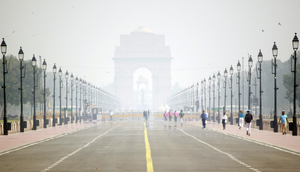New Delhi: As the mercury began coming down in Delhi-NCR, the region’s pollution woes saw a turn for the worse. Air pollution in Delhi-NCR rose sharply post-Diwali and air quality levels in the capital and its neighbouring cities breached the ‘very poor’ and ‘severe’ category across numerous locations.
The Air Quality Index (AQI) has exceeded 400 in many parts of Delhi, reflecting hazardous conditions for residents.
Similarly the AQI in Gurugram in Haryana touched the ‘severe plus’ category as it hit the 499 mark, while Noida in Uttar Pradesh saw ‘poor’ air quality with the AQI at 297 and Greater Noida ‘very poor’ air with the AQI at 346.
According to the Central Pollution Control Board (CPCB), 11 out of Delhi’s 39 monitoring stations recorded AQI levels over 400, placing them in the ‘severe’ pollution bracket.
Forecasts from the Meteorological Department indicate little reprieve, with smog expected to blanket the city until at least November 10.
On Tuesday morning, the AQI in Mundka soared to 466, DIT saw levels at 442, Anand Vihar registered 438, and New Sarup Nagar reported 395. Additional locations faced similar severe levels, with Kohat Enclave at 384, Bhalswa Landfill at 368, LIC Colony at 364, and Rohini at 391.
Other areas such as Pusa (325), Loni (324), Alipur (320), Ashok Vihar (318), Dwarka (316), Janakpuri (306), Hastsal (307), and Jawaharlal Nehru Stadium (309) recorded AQI levels within the ‘very poor’ range.
The CPCB classifies AQI levels as follows: ‘good’ (0-50), ‘satisfactory’ (51-100), ‘moderate’ (101-200), ‘poor’ (201-300), ‘very poor’ (301-400), and ‘severe’ (401-450), with any AQI above 450 categorised as ‘severe plus.’
Adding to the challenging air quality, the Meteorological Department has predicted a maximum temperature of 32 degrees Celcius and a minimum of 16 degrees Celcius for Tuesday, similar to Monday’s temperatures, which were 1 degree Celcius to 1.2 degrees Celcius above normal.
In response, the Commission for Air Quality Management (CAQM) has implemented several initiatives to mitigate pollution, including the Graded Response Action Plan (GRAP).
Stringent penalties have been imposed on polluting construction sites, vehicles, and industries while road dust control efforts are underway, with approximately 600 mechanical road-sweeping machines, water sprinklers, and anti-smog guns deployed across the National Capital Region (NCR).
–IANS


Comments are closed.